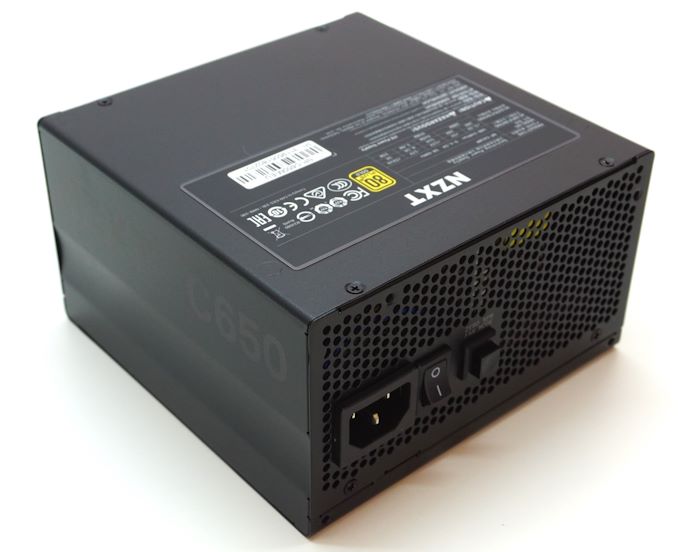The NZXT C650 650W PSU Review: Designed To Last
by E. Fylladitakis on August 11, 2020 8:00 AM EST- Posted in
- Cases/Cooling/PSUs
- PSUs
- 80Plus Gold
- NZXT
- 650W
- Modular
Conclusion
NZXT designed the C650 to land in the sweet spot of price and performance – offering excellent performance while remaining competitively priced – with an eye towards enticing enthusiasts who want to purchase an advanced PSU without breaking the bank. It's a great spot for buyers, but for manufacturers it can be a difficult one to compete in, especially with the prices of more advanced PSUs dropping with each passing day.
With its all-black chassis and cables, the NZXT C650 is an aesthetically neutral product, designed to subtly match the interior of any modern PC system. It features no lighting, which is a good thing for users that want to actually prevent the PSU from becoming the center of attention. Although NZXT is a company that enjoys making visually extravagant products, it seems that they preferred to keep the attitude - and cost - down on this one.
Quality is the strongest selling point of the NZXT C650. It is a unit based on a platform from Seasonic, arguably the most reputable PC PSU OEM, and it also happens to be a platform that was originally developed with long-term reliability in mind. The platform is designed so as to be efficient with the least possible stress on its parts, while the parts are all top quality products supplied by highly reputable manufacturers. It is no wonder why NZXT backs this unit up with a 10-year warranty – it is a product that, above all else, is designed to last.
The performance of the NZXT C650 is very good overall, with the designer clearly focusing on the power quality of the 12V line given the excellent figures we measured from the 12V rail. Readings from the 3.3V and 5V rails were not quite as good, though this isn't unique to NZXT, as most manufacturers tend to neglect the secondary voltage lines just a bit in favor of the major 12V line. The C650's thermal performance and acoustics were also well-balanced, creating a PSU that is quiet when expected and cool enough that it's not struggling to maintain that quiet nature.
As a result, the NZXT C650 is a great PSU overall, with NZXT making the right choice to focus on quality and longevity. The $110 price tag on the PSU is a little bold for an 80Plus Gold unit, and its current availability is rather limited – presumably due to COVID-released shipping backups – which is challenging the market potential of the product. Nonetheless, we feel that the very high quality and estimated longevity of the C650 will entice a significant portion of advanced users and enthusiasts, who enjoy purchasing products that will last them for many years to come.












34 Comments
View All Comments
qlum - Tuesday, August 11, 2020 - link
While they generally do have the extra 4 pin, actually plugging it in is completely optional unlike the extra connector on gpu's. In terms of power requirements it's also completely unnecessary to use it. The extra 4 pin is mostly the motherboard manufacturer showing look at our beefy vrm rather then actual need.MrVibrato - Tuesday, August 11, 2020 - link
No. Your AM4 CPU doesn't require 8+4. It's called gamer street cred.Wait...
Is it even possible for gamers to have street creds?
MrVibrato - Tuesday, August 11, 2020 - link
Darn... wrong reply button... was supposed to be a reply to Amoro's post...eek2121 - Tuesday, August 11, 2020 - link
I wouldn’t say most. The more affordable boards do not. My board has a single 8 pin. Anything above and beyond that is a gimmick.ArmedandDangerous - Tuesday, August 11, 2020 - link
You only need the 1 8 pin. Anything extra is for much more exotic overclocking the majority of people will never need.PenGunn - Tuesday, August 11, 2020 - link
As always, just get the Seasonic that fits your purpose.eek2121 - Tuesday, August 11, 2020 - link
I accidentally bought a Seasonic PSU thanks to Amazon’s infuriating inability to do a proper search. Still trying to decide whether to keep it or return it.evilspoons - Tuesday, August 11, 2020 - link
Small nitpick on the "Main Output" table on the Hot Test Results page. At 20% you read 5.05 V, at 50% you read 5.01 V, and at 100% you read 4.97 V. All two decimals of precision. However, at 75% load it's just listed as "5 V". Shouldn't that be "5.00"?fred666 - Tuesday, August 11, 2020 - link
What's the point of being 100% modular? Is someone really going to use this without the main ATX motherboard connection?It looks nice in the box, but I don't see any real-world advantage.
eek2121 - Tuesday, August 11, 2020 - link
The cables can easily be replaced. For example, cablemod allows you to purchase custom length cables. Also, what if a connector or cable breaks?